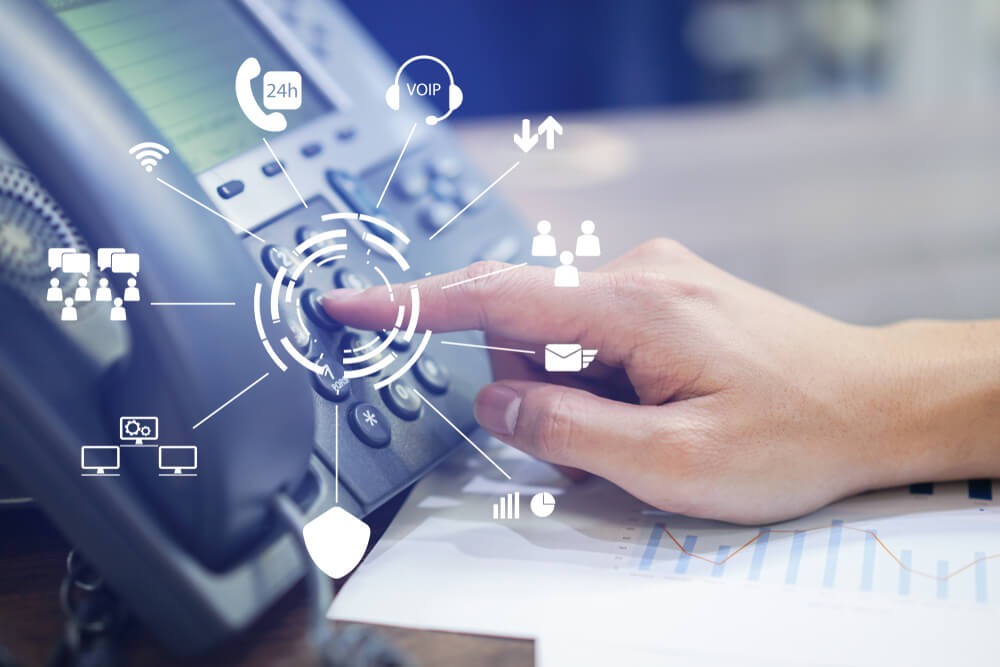The telephone is one of the most important tools for businesses. It boosts lead generation, sales, productivity, and trust. And despite all the different ways to contact a business today, many people still prefer to pick up the phone and speak to a person.
But consistently delivering 5-star customer service is harder than it sounds. It takes commitment and a solid process to produce outstanding customer service 24/7.
An inbound call-handling process is a must when you take calls every day. So what is inbound call handling?

What is inbound call handling and why is it important?
An “inbound call” is when a person tries to contact a business via the telephone. “Inbound call handling” is a business’s ability to manage the inbound calls they receive. It’s a key area to master as it has a big impact on your business.
We commissioned Arlington Research to conduct a study into the importance of the inbound phone call:
- By missing 30% of inbound calls, businesses lose $1.6 million in yearly revenue.
- 64% of calls hang up if they cannot reach a person within five minutes of calling a business.
- 4 out of 5 people prefer to speak with a human over the phone.
Effective call management captures more leads, more sales, builds trust, and boosts your productivity. Whereas, ineffective inbound call handling does the opposite. While missing a few calls here and there may not seem like a big deal – the studies show that it is.
What is inbound call handling’s impact on brand experience?
Customers’ first impressions matter. And loyal customers who have spent money on your products and services expect a good level of service when they get in touch.
Productivity has a risk of overshadowing customer service. Voicemail machines, bots, and AI tools are part of companies’ inbound call-handling strategies but studies show customers would rather talk to a real person:
- 80% of customers said customer experience is as important as products or services.
- 73% of consumers say they would rather do business with a competitor after one bad experience.
- 78% of customers who interact with chatbots say they end up needing to speak with a human agent anyway.
AI and bots have value but they can’t deliver exceptional customer service like humans. So the sooner a virtual receptionist talks to a caller, the better. This is often overlooked. Many leads enter pipelines via email inquiry or a lead capture form. From there, they could wait a long time to speak with a receptionist.
Slow responses invite callers to seek help from competitors. A smooth inbound call-handling process helps deliver a great experience for everyone.

The importance of effective call management for small businesses.
Small and medium sized businesses across the US miss huge amounts of phone calls, which affects revenue, opportunities, and reputations. 45% of all inbound calls generate a new inquiry. It’s hard to grow when leads slip away. Just as importantly, those missed calls can tarnish the customer experience and damage your reputation.
Make every caller feel valued
Having a system in place to answer calls creates a professional image and shows customers you’re there to help.
Strangely, some of the world’s biggest companies make it tough for customers to get help. The “Contact Us” button is hidden away on their websites. And they often direct people to online forums for help, or use bots that aren’t equipped to answer basic questions.
Simply having your phone lines open with a call-handling process in place can help you get the edge over your competitors, no matter how big they are.
Boost productivity
3 out of 5 employees juggle answering telephone calls with other work. A call-handling process helps you focus on your most important goals as calls will be directed to the right person/department.

Common inbound call-handling methods used by small businesses.
Call routing
A call routing protocol is set up to manage the different types of calls, so they can be sent to the right person/department efficiently. This is a big time saver and valuable customer service tool when you have VIPs or urgent cases on the line who require immediate attention.
Interactive Voice Response (IVR)
IVR technology automatically accepts calls and guides callers with pre-recorded voice messages and touch-tone keypad inputs; callers navigate themselves to the right department. This way, receptionists have a basic understanding of customer needs before they take the call.
Call queues
Once a company reaches call capacity, the overflow is added to the call queue. A pre-recorded announcement will be read out so callers know their position in the queue. There’s also a callback option, where a caller can hang up but their position is held; the company automatically calls them back when an agent is free.
24/7 live answering services
Small businesses can outsource inbound call handling to a 24/7 live answering service, where a team of friendly virtual receptionists answer calls on their behalf. They offer a great level of customization so customers won’t know they’re talking to an answering service. Their virtual receptionists sound just like you.
Answering services offer many inbound call-handling services to streamline small businesses’ workflow. Common services include:
- 24/7 live phone and live chat assistance (with bilingual options).
- Lead capture and qualification.
- Order management (ecommerce, retail, etc.).
- Appointment booking.
- A business telephone number (for work-life balance), and more.
“To grow a business you need to make sure you’re capturing every call, whenever they come in. It’s much more than inbound call handling: it’s building customer relationships and developing real human connections. It’s the heart of your business.”
Natalie Ruiz – AnswerConnect CEO

The benefits of professional call handling for small businesses.
Improved customer service
64% of callers hang up if they cannot speak to a person within five minutes of calling. Letting the phone ring to no avail or using a voicemail machine annoys callers. Improving call response times with an inbound call-handling process makes customers feel valued.
Increased efficiency
Optimizing inbound call workflow protects your schedules. Phone lines won’t be overwhelmed, callers get a smoother experience, and teams can focus without worrying about phone lines.
Enhanced call resolution
Addressing issues promptly and effectively is a win for you and your customers. Customers are helped faster and cases don’t drag on and interrupt your workflow.

Simple inbound call-handling strategies used by small businesses.
1. Personalized call routing.
This is common, and often essential, for businesses with complex sales cycles and multiple locations. For example, a real estate company with locations across the US expects a high volume of calls with each caller needing a different department.
The customer journey is broken up into different lines for “residential sales”, “commercial leadings” or “property management”, etc. Callers get forwarded to the right department fast and receive the right services efficiently.
2. Prompt issue resolution.
Some issues can throw a spanner in the works and need to be addressed ASAP. That could be a last-minute cancellation or an emergency that requires immediate attention. Ensuring customer problems are addressed fast shows customers you care while tackling the problem before it gets worse.
For example, a real estate company may demand all agents have a CRM/live answering service app on their phones to check appointments regularly as last-minute cancellations/rescheduling appointments are a big problem.
3. Data-driven decision making.
Customer conversations reveal a lot about your business and the market. If you don’t notice it when on the phone yourself, data and analytics can help you spot trends.
A simple example would be learning that 70% of callers want a specific department, so it would make sense to make this department the first that’s read out on your IVR system. This way, you’re providing a faster service to the majority of your customers.

The importance of the human touch in inbound call handling.
People have been using the telephone to call businesses since the mid-19th century. The phone call has been important for decades but some companies place convenience over customer service, which makes it hard for callers to speak to someone when they call.
The “human touch” is vital. First impressions matter and when customers need an issue resolved ASAP, they don’t want to be stuck in your call queue. They want to speak to a person. So a team of friendly, well-trained virtual receptionists with industry knowledge is essential for great customer service.

Entry-level technologies in inbound call handling.
Artificial intelligence (AI) call centers.
AI has been working its way into the workplace and has found a home assisting call handling. There’s a wave of AI tools that offer (AI) virtual assistants, chatbots, personalized customer engagement, and automated call routing.
The technology isn’t quite there to rival a human-led call center yet, it’s more of an enhancement than an alternative at this stage.
Cloud-based call-handling software.
The traditional approach for call-handling software was installed in local servers or in hardware infrastructures. Cloud-based software offers greater flexibility and scalability, which is a giant benefit as call volumes tend to fluctuate through the year.
Inbound call integrations.
Businesses do what they can to streamline their processes. Integrations are hugely valuable in this sense as you can find a better way of working using the tools you already know and love.
Common inbound call integrations include:
- CRM software
- Helpdesk and ticketing systems (Zendesk, ServiceNow, Kayako, etc.
- Analytics and reporting tools
- Workforce management software.

Getting started with inbound call-handling best practices.
1. Create customized call scripts.
Consistency is key. Map out your customer journey for every service and product as this will help you identify the different types of call scenarios. Then, visit your brand guidelines to make sure your brand values shine through on every call.
2. Train agents with industry-specific knowledge.
A poorly managed call is as bad as a missed call. Take the time to find virtual receptionists who have the industry knowledge you need or take the time to train them up to standard.
3. Collect feedback to keep customer satisfaction high.
Technology and trends are always changing. Pay attention to customer feedback and industry trends to see what you can do to keep your customers happy while looking for opportunities to go above and beyond your competition.



